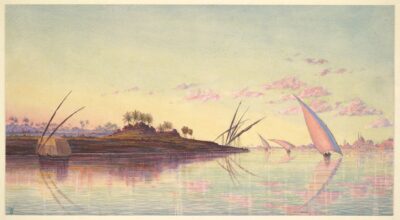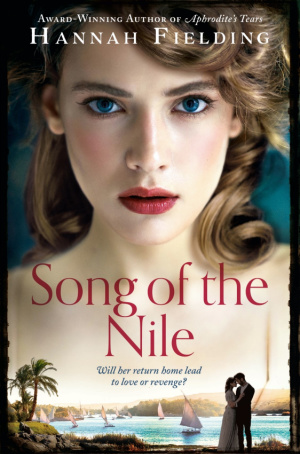The romance of feluccas on the Nile
The romance of feluccas on the Nile
The romance of feluccas on the Nile
-
Hannah
-
Hannah

In Song of the Nile, the terrace of Aida’s home affords a serene view:
From here the view was breathtaking: the slow-moving Nile lying like a pearlescent sheet, so still it seemed as though you could walk across the water to the farthest bank, where the pink hills of the Valley of the Tombs rose up, changing colour as the sun rode the sky. During the day, feluccas, the romantic gull-winged sailing boats used since antiquity, skimmed over the surface of the river like big white moths.
The feluccas move so gently, meandering dreamily, propelled by nothing more than the breeze, just as they were in ancient times. Their lateen sails (narrow, triangular sails set on a very long yard that is usually longer than the boat) are like wings that reflect the light around, as in this 1855 watercolour painting by British artist Thomas Seddon, entitled View on the Nile near Cairo, where the sails take on the warm hues of the sunset.

It is not only the sight of the feluccas that sets the scene in my memory but also the sound of them: the creaking of the windlass, the whine of great sails, the chains rattling as they moor, even the baaing of sheep as a felucca crowded with animals moves towards a bridge, which then slowly creaks open with the help of the most antique of machinery to let the high masts pass through.
If watching the feluccas from the bank stirs a sense of romance, imagine how it feels to take in views of Upper Egypt from the deck of one of these boats. In Song of the Nile, that is exactly what Phares and Aida do:
Phares had been right: the breeze on the beautiful river shining like glass in the splendid light was stronger than it had seemed from the bank. Filling their sails, it carried them along at a brisk rate, the smooth surface rippled in the wind like the curls of a sheep’s back… The view slid by, of feluccas dozing with folded sails, lying on their sides like seabirds asleep; endless fields of corn, wheat, beans, cotton and sugarcane stretching afar; and the tiny, unreal villages, their mud walls and winding ways fringed by palms looking like bottlebrushes. …
As the felucca approached the shores of Luxor, broken pillars of temples were outlined against the horizon… Aida continued to consider the landscape, ever rich in tropic beauty – the sweep of the majestic river, the eternal silence of the sand plains, and the desert hills that lay in the distance. Here, it was impossible to separate the Egypt of the past from the Egypt of today, she mused.

With such romance in the air, how can Aida and Phares help but be swept away?
Song of the Nile will be published in ebook format on 14th February exclusively on my website. Preorder the book at https://hannahfielding.net/song-of-the-nile/ and you’ll get an early bird discount!